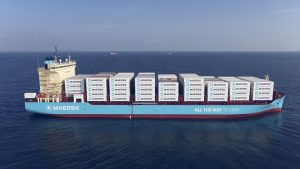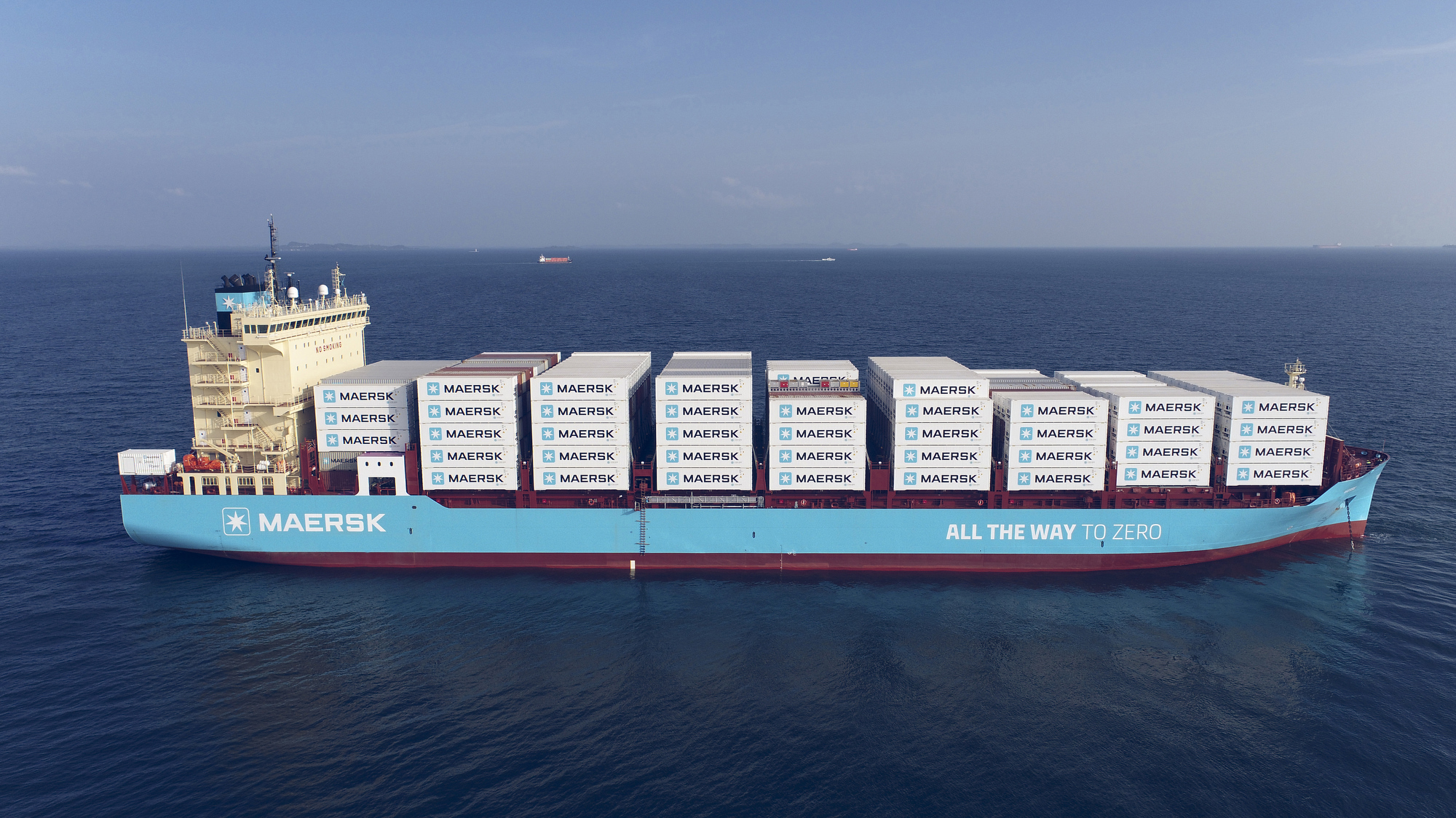
Credit: https://www.aboutamazon.com/news/sustainability/amazon-zero-carbon-shipping
Discover how Maersk’s methanol-powered vessels are driving zero-carbon shipping. Explore innovations, challenges, case studies, and the future of green shipping fuels.
In September 2023, the maritime world witnessed a symbolic moment in the decarbonization of global shipping. A.P. Møller-Maersk, the Danish shipping giant and one of the largest container carriers in the world, launched its first methanol-powered container vessel in Copenhagen, Denmark. The 172-meter feeder ship, capable of carrying over 2,000 TEU, may appear modest compared to the ultra-large container vessels dominating global trade lanes. Yet its maiden voyage signaled something much larger: the beginning of a new chapter in the use of alternative marine fuels.
Shipping accounts for approximately 2–3% of global greenhouse gas (GHG) emissions, roughly on par with the aviation sector. If left unchecked, emissions could rise to 5–8% by 2050, making the maritime industry a major obstacle to international climate goals. The International Maritime Organization (IMO) has responded with an ambitious GHG reduction strategy, calling for net-zero emissions “by or around 2050.” Against this regulatory and environmental backdrop, Maersk has taken bold steps to pioneer the use of green methanol as a marine fuel.
Methanol offers a promising pathway because it can be produced from renewable feedstocks, stored and transported using existing infrastructure, and burned in dual-fuel engines with relatively mature technology. Maersk’s investment in methanol-powered vessels represents not only a corporate sustainability strategy but also a potential turning point for the entire shipping industry.
This article explores why methanol matters, how Maersk is implementing it across its fleet, the challenges ahead, and what this means for the broader maritime world.
Why This Topic Matters in Maritime Operations
Decarbonization is no longer an abstract goal for shipping companies; it is a strategic necessity. Several forces make Maersk’s methanol adoption critical for maritime operations:
-
Regulatory Pressure
-
The IMO’s revised GHG strategy (2023) sets a trajectory for net-zero emissions by mid-century.
-
Regional policies like the EU Emissions Trading System (ETS) and FuelEU Maritime impose financial costs on carbon-intensive fuels.
-
The U.S., China, and other major economies are exploring stricter maritime decarbonization measures.
-
-
Market and Customer Expectations
-
Cargo owners, including companies like Amazon, IKEA, and Unilever, demand low-carbon shipping solutions.
-
The Zero Emission Maritime Buyers Alliance (ZEMBA) exemplifies the shift where shippers pool demand for green transport.
-
-
Technological Readiness
-
Methanol dual-fuel engines are commercially available today, unlike hydrogen or ammonia systems, which remain in early development stages.
-
Infrastructure synergies exist: methanol is liquid at ambient temperatures, making it easier to handle than LNG or hydrogen.
-
-
Economic Competitiveness
-
Early movers like Maersk position themselves to access green financing, subsidies, and premium freight contracts.
-
Long-term competitiveness will hinge on the ability to meet tightening Carbon Intensity Indicator (CII) requirements and avoid regulatory penalties.
-
In short, Maersk’s methanol program is not simply an environmental initiative; it is a commercial, regulatory, and operational strategy with implications across global trade.
Key Developments, Innovations, and Technologies
Methanol as a Marine Fuel
Methanol (CH₃OH) is one of the simplest alcohols and has long been used in industry as a chemical feedstock. In shipping, methanol can be used in two main forms:
-
Fossil-based methanol (derived from natural gas or coal).
-
Green methanol (produced from renewable sources such as biomass, municipal waste, or captured CO₂ combined with renewable hydrogen).
Green methanol offers the potential for up to 95% reduction in lifecycle emissions compared to conventional marine fuels, depending on feedstock and production pathway.
Key advantages include:
-
Liquid at ambient temperatures and pressures (unlike LNG or hydrogen).
-
Compatible with existing bunkering systems with minor modifications.
-
Lower emissions of sulfur oxides (SOx), nitrogen oxides (NOx), and particulate matter.
However, methanol has a lower energy density than heavy fuel oil (HFO) or LNG, meaning ships must carry more fuel volume or bunker more frequently.
Maersk’s Fleet Transformation
Maersk has committed to operating at least 25 methanol-capable container vessels by 2027. These ships, ordered from major shipyards like Hyundai Heavy Industries, represent a mix of feeder vessels and large 16,000+ TEU ships designed for mainline Asia–Europe and Transpacific trades.
Key innovations include:
-
Dual-Fuel Engines: Developed by MAN Energy Solutions, capable of running on both methanol and conventional fuels.
-
Fuel Supply Systems: Integration of methanol-compatible pumps, tanks, and safety systems.
-
Retrofit Strategy: In addition to newbuilds, Maersk is exploring retrofitting parts of its fleet to methanol capability.
This transformation is not only technical but also financial. Each methanol-powered ship comes with a price premium of 10–15% compared to conventional vessels, requiring long-term contracts and customer backing to justify the investment.
Partnerships and Supply Chain Development
Fuel availability is a major challenge. Maersk has signed multiple agreements with producers worldwide to secure green methanol supply:
-
European producers using biogas and renewable electricity.
-
Asian initiatives leveraging biomass and waste-to-energy pathways.
-
Latin American projects focusing on renewable hydrogen-based methanol.
These contracts are essential to ensuring a reliable bunkering network across key trade lanes. By creating demand signals, Maersk incentivizes producers to scale up production capacity.
Challenges and Practical Solutions
While promising, the methanol pathway faces several obstacles.
Limited Supply of Green Methanol
-
Current global production of green methanol is less than 500,000 tonnes annually, while Maersk alone will require millions of tonnes to fuel its fleet.
-
Scaling production requires massive investments in biomass processing, carbon capture, and renewable hydrogen infrastructure.
Solution: Public-private partnerships, subsidies, and guaranteed offtake agreements can help bridge the gap until economies of scale lower costs.
Cost Premiums
-
Green methanol can cost 2–3 times more than heavy fuel oil.
-
Shipowners must convince cargo owners to pay a “green premium” for sustainable logistics.
Solution: Mechanisms such as green corridors, where governments subsidize sustainable fuel use on key routes, can demonstrate viability and reduce cost disparities.
Technical and Safety Concerns
-
Methanol is toxic and requires careful handling.
-
Crew training, updated safety codes, and port readiness are essential.
Solution: Organizations like the International Maritime Dangerous Goods (IMDG) Code and classification societies (e.g., DNV, Lloyd’s Register) are developing guidelines for methanol handling and ship design.
Lifecycle Emissions Verification
-
Not all methanol is “green”; fossil-based methanol offers limited climate benefits.
-
Transparent certification systems are required to prevent greenwashing.
Solution: Standardized certification frameworks (such as ISCC PLUS and EU RED II compliance) can ensure only verifiable renewable methanol counts toward decarbonization targets.
Case Studies / Real-World Applications
Maersk’s Feeder Ship (2023)
The first methanol-fueled vessel, named Laura Maersk, successfully completed voyages across Europe. Its launch event in Copenhagen showcased not only the technology but also political and commercial support, with leaders from the European Commission and IMO attending.
Partnerships with Cargo Owners
Maersk has signed green shipping contracts with companies like H&M, Amazon, and Volvo. These agreements lock in customers willing to pay premiums for carbon-neutral transport, creating a stable revenue base for methanol-fueled operations.
Industry Parallels
-
Proman Stena Bulk has already launched methanol-powered tankers.
-
COSCO Shipping and CMA CGM are exploring methanol in addition to LNG.
These examples show methanol is gaining traction beyond Maersk, though Maersk remains the clear industry leader.
Future Outlook & Trends
-
Scaling Green Methanol Production
-
By 2030, global green methanol capacity could exceed 10 million tonnes annually if planned projects materialize.
-
Regions with abundant renewable energy, like Latin America and the Middle East, may become key exporters.
-
-
Integration with Other Fuels
-
Methanol may serve as a bridging fuel until hydrogen, ammonia, or synthetic fuels mature.
-
Hybrid pathways are likely, with ships using multiple alternative fuels over their lifetimes.
-
-
Policy and Incentives
-
Carbon pricing, subsidies, and green corridor initiatives will accelerate adoption.
-
The IMO may eventually require minimum shares of alternative fuels.
-
-
Wider Adoption Across Fleets
-
If Maersk’s program proves successful, other top carriers like MSC, COSCO, and Hapag-Lloyd will follow.
-
Scale effects could reduce costs and accelerate infrastructure readiness.
-
FAQ Section
Q1: Why did Maersk choose methanol instead of LNG or ammonia?
A: Methanol is available today, compatible with existing technology, and easier to handle than LNG or ammonia. LNG reduces CO₂ but still emits methane, while ammonia technology is less mature.
Q2: Is methanol completely carbon-neutral?
A: Only green methanol produced from renewable sources offers near-zero lifecycle emissions. Fossil-based methanol does not provide the same benefits.
Q3: How safe is methanol for ship crews?
A: Methanol is toxic but manageable with proper safety protocols, training, and equipment. Classification societies have issued guidelines to ensure safe handling.
Q4: Will methanol replace all marine fuels?
A: Not necessarily. Methanol is one of several alternative fuels. It may dominate in some sectors, while ammonia, hydrogen, and biofuels serve others.
Q5: How much more expensive is methanol compared to fuel oil?
A: Currently, green methanol can cost 2–3 times more. However, as production scales, prices are expected to fall.
Q6: Can existing ships be converted to methanol?
A: Yes, some vessels can be retrofitted, though it requires modifications to fuel systems, tanks, and engines.
Q7: When will methanol be widely available for shipping?
A: Significant growth is expected by 2030, with production hubs emerging in Europe, Asia, and Latin America.
Conclusion
Maersk’s methanol-powered vessels represent a pioneering step toward a cleaner, greener future for global shipping. By investing in dual-fuel ships, securing green methanol supply chains, and partnering with cargo owners, Maersk has positioned itself at the forefront of maritime decarbonization.
While challenges remain — from fuel supply shortages to cost premiums — the momentum behind methanol suggests it will play a critical role in the industry’s transition. Whether it becomes the dominant long-term fuel or a bridge to even more advanced options, its adoption signals that zero-carbon shipping is no longer a distant dream but an operational reality.
For maritime professionals, policymakers, and shippers alike, the key takeaway is clear: collaboration, innovation, and commitment are essential to building a sustainable future for global trade.
References
-
International Maritime Organization (IMO). (2023). Revised GHG Strategy.
-
International Chamber of Shipping (ICS). (2022). Decarbonization Roadmap.
-
DNV. (2023). Maritime Forecast to 2050.
-
Lloyd’s List Intelligence. (2023). Alternative Fuels in Shipping.
-
European Commission. (2023). FuelEU Maritime Regulation.
-
Wärtsilä. (2022). Methanol as a Marine Fuel – Technical Report.
-
The Maritime Executive. (2023). Maersk Launches First Methanol-Powered Container Ship.
-
Marine Insight. (2023). Methanol Fuel Explained.
-
UNCTAD. (2022). Review of Maritime Transport.
-
Ocean Engineering Journal. (2022). Lifecycle Assessment of Alternative Marine Fuels.


Your blog continues to be a reliable source of information. This post was particularly informative.
The level of detail in this article is commendable.
I have gained a better understanding of the topic.
Your writing consistently provides valuable information. This post was particularly enlightening.